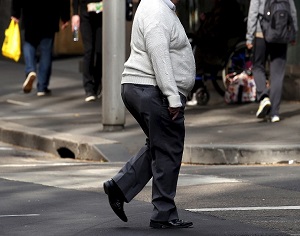Image: A man crosses a main road as pedestrians carrying food walk along the footpath in central Sydney, A REUTERS/David Gray
![]()
By Lisa Rapaport
Reuters Health – Obesity rates may surge in places where artificial lights blaze all night compared to communities where people tend to live in darkness after the sun goes down, a recent study suggests.
To explore this connection, researchers analyzed U.S. military satellite images of nighttime illumination around the globe and country-level data from the World Health Organization (WHO) on the prevalence of overweight and obese people.
Artificial light at night contributed to excessive weight in men and women about as much as eating junk food, the research team reports in the International Journal of Obesity.
“Because of artificial light at night, we often eat in the wrong time, that is, after the natural dusk, when metabolic processes slow down,” said N.A. Rybnikova of the University of Haifa in Israel.
The study doesn’t prove light bulbs cause obesity, and scientists aren’t yet certain how lamps or the glow from gadgets like tablets and televisions might influence how much people weigh, researchers caution.
But it’s possible artificial light might contribute to obesity by suppressing the production of melatonin, a hormone that helps regulate sleep cycles.
These lights may also contribute to what’s known as social jet lag, or disruption of the body’s natural circadian rhythms that happens when people sleep and wake at times that are at odds with their internal biological clocks.
For women and men, higher birth rates appear to be one of the stronger predictors of excess weight and obesity.
Urbanization, as well as calorie intake of oils, fats and carbohydrates also appear to predict excessive weight in men and women alike. Consuming more roots and tubers was linked to a lower likelihood of excessive weight, the study also found.
Together with variables like eating habits and exercise levels, nighttime light explains up to about 73 percent of the variation in rates of excess weight and obesity in women and up to 68 percent in men, the study found.
The researchers also calculated overweight and obesity prevalence for different levels of “Artificial Light-at-night,” or ALAN, using a scale of zero to 1,000 ALAN (the highest observed level in 2010). They found that overweight and obesity rises with ALAN intensities, by 250 percent in most countries and 900 percent in Asia, at the highest light levels compared to the lowest.
The study builds on earlier research linking excessive weight to the use of tiny screens and other sources of light in bedrooms at night, the authors note.
“The evidence that exposure to artificial light at night is associated with metabolic disturbances is continuing to accumulate,” said Laura Fonken, a researcher at the University of Colorado who wasn’t involved in the study.
“Overall, it’seems that there aren’t any downsides to trying to keep a consistent sleep schedule and avoid nighttime light exposure,” Fonken added by email.
Just turning off smartphones and tablets and dimming the lights at night probably won’t help with weight loss, cautioned Illa Karatsoreos, of the Sleep and Performance Research Center at Washington State University in Pullman.
“But if these things are disrupting your normal patterns of sleep, and disrupted sleep is contributing to the problem, then these steps would help,” Karatsoreos, who wasn’t involved in the study, added by email.
“Anything to improve one’s ‘sleep hygiene’ like reducing light and noise at night should help improve sleep quality, and this may help your body work more efficiently,” Karatsoreos added.
“We seem to be finally waking up to the realization that disrupted sleep and biological rhythms are associated with many health problems, including metabolic disruption, obesity, and cardiovascular disease,” Karatsoreos said.
SOURCE: http://bit.ly/1P20TOg International Journal of Obesity, online February 23, 2016.
Copyright 2015 Thomson Reuters. Click for Restrictions.
Can-bright-light-at-night-lead-to-obesity–media.jpg


